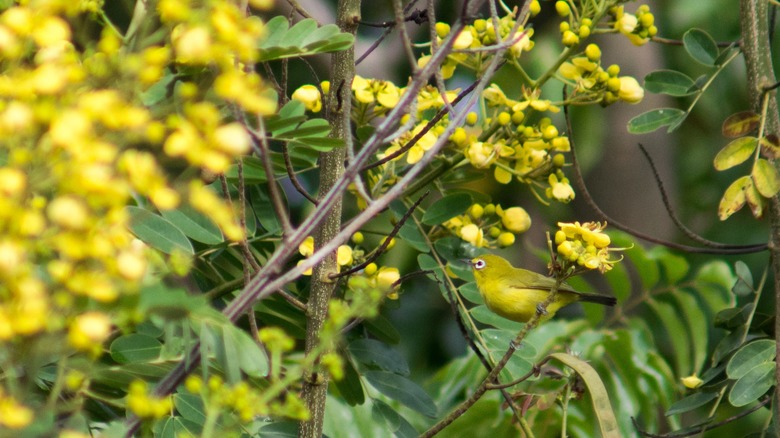Attract Nesting Birds To Your Yard With A Yellow-Flowering Fall Shrub
If you're a bird lover, you probably enjoy pulling out the field guide and watching the birds flutter around your yard, adding some extra life and color to your outdoor space. Attracting birds isn't just a nice activity to watch; it's also a great method for ensuring the health of your garden. Birds help to control pests, pollinate flowers, and spread seeds, making them valuable contributors to your backyard ecosystem. To encourage more birds to visit and nest in your garden, you need to provide an inviting habitat. You can set out nesting materials, keep a birdbath with cool water, and plant shrubs or trees that offer shelter, food, and eye-catching colors to turn your yard into a bird haven.
One excellent option for drawing in birds while adding in a bright burst of color is the Cassia fistula, or golden shower. The cassia tree is a deciduous, yellow-flowering shrub that is known for its clusters of bright yellow flowers that bloom from late summer into the fall. Not only do they add vibrancy to your garden as the seasons change, but they're also a magnet for a variety of bird species. Whether you want to create a nesting space for birds or simply enjoy their presence in your yard, the cassia tree is a great option to add both beauty and a functional habitat. Cassia can be grown as either a shrub or a tree, depending on how it is pruned, so gardeners have flexibility in shaping it according to their preferences.
How to grow cassia and what birds it attracts
Cassia is relatively easy to grow, making it a great choice for gardeners of all levels. The shrub grows best in USDA hardiness zones 8 through 11, where it enjoys full sun and well-drained soil. Although an established cassia is a drought-resistant plant, it requires regular watering during dry periods in order to keep the foliage lush with plenty of blooms. For the best flower display, plant your cassia shrub in a sunny spot. It can handle poor soil, but mixing in some compost or organic material will help to boost its growth and flowering.
As the cassia flowers bloom, they provide a rich source of food in the form of nectar and insects that birds love to eat! The thick, bushy foliage also provides excellent cover and nesting spots for smaller birds like finches and sparrows. Plus, you might even see butterflies and carpenter bees enjoying the tree, making it an integral part of your garden's ecosystem. However, it's important to note that cassia seeds are considered poisonous if ingested, so care should be taken if children or pets are in the yard.

